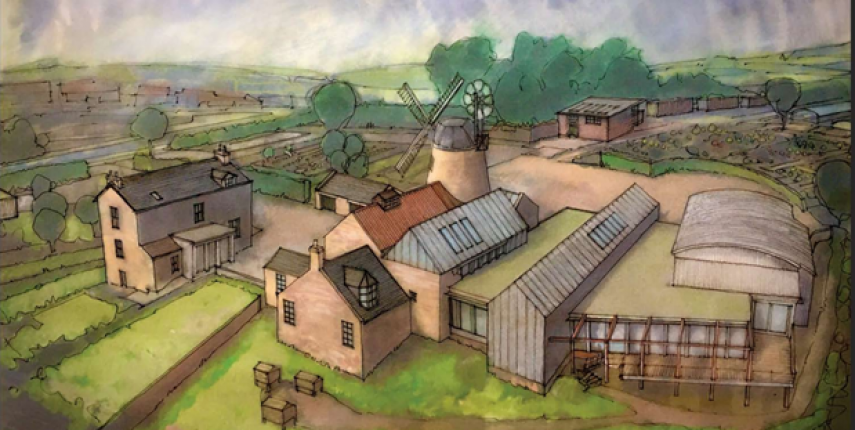Carluke High Mill & Community Growing & Learning Garden – Carluke Development Trust
Project Overview
Carluke High Mill was built in 1801 in Carluke town centre. Close to the High Street, surrounded by houses and across the road from two schools, it is a prominent site within the community. As the most complete windmill in Scotland, it is a Category A listed building but is on the Buildings at Risk register and the wider site is classed as one of Scotland’s “stuck sites” as it has been derelict for more than 20 years. All of this makes it a complicated but worthwhile site to bring back into use.
The Carluke community have held long-standing ambitions to bring the High Mill back to life. Through a series of “Carluke Conversations” the community developed their vision for the site as a heritage tourism destination which also meets the needs of the town’s residents.
The site surrounding the building is being developed as a community growing and learning garden, with space for the community food hub and outdoor classrooms which will be used by the nearby schools.
The building itself will deliver indoor community facilities and rentable high-end events space along with the heritage attractions in the mill tower itself.
Progress
Carluke Development Trust took ownership of the site in 2018, purchasing it from a private landowner through a negotiated sale. Prior to this a feasibility study and business case had been undertaken along with a lot of community consultation, to develop their proposals for the site.
Since gaining ownership, CDT have secured planning permission and listed buildings consent granted in October 2020 and have since been fundraising, enabling detailed design works by a multi-disciplinary team of consultants to be commissioned.
Whilst design works for the buildings are underway, the visible community action has been on developing the surrounding land. With the assistance of local volunteers, development of the community growing and learning garden is underway, complete with solar powered, rain water capture and distribution systems which will reduce the facility's impact on the environment.
Repair of the historical buildings is hoped to begin mid-2022 and construction of the new buildings thereafter, all funding dependant.
Key Learning
“The quicker a project can deliver any form of activity the better. As this will bring in your community who will then start to ask questions, become more involved and will see the activities that they can access, which will also provide tangible evidence to funders.
We have created a resource that funders can physically see the benefits of their investment, rather than just a piece of paper with aspirations and aims, which of course we had to do at the beginning.”
Funding and Resources
Across all stages of this project, community volunteers have been at the centre of its development. They have been central to advocating for the development and conducting conversations with the community and key partners.
The early stages of the project were funded by the Architectural Heritage Fund which led to a successful bid to the Scottish Land Fund in 2018, allowing the community to purchase the site from the private owner. In 2020 the project joined the DTAS / Scottish Land Commission partnership project which assists community-led organisations bringing new uses to V&DL.
Funding for the growing and learning garden has since been secured from the Community Climate Asset Fund and the Vacant & Derelict Land Investment Programme, allowing the garden to be fully developed in 2021/22. Funding for the repair of the tower and capital development of the site is currently being raised, with committments from Historic Environment Scotland and National Lottery Heritage Fund to enable the detailed design and a wider funding package being secured for construction.
As the project develops and delivers it will implement a range of activities to ensure the long-term sustainability of the community resource:
- Community benefit activities, workshops, and programmes.
- Income generation activities, including rental of local markets, the sale of produce, hanging baskets, potted plants, Carluke High Mill merchandise.
The heritage tourism aspects will bring visitor footfall alongside hosting of local events. Partnerships with local groups being based or using the site will also bring in a small income.
Find out more
Tom Sneddon
Founding Member of Carluke Development Trust
Carluke High Mill
